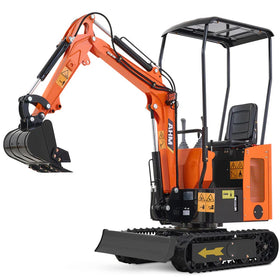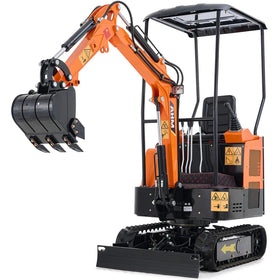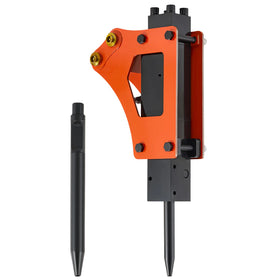Landscaping projects—whether leveling soil, planting trees, or digging trenches—require the right tools to finish efficiently. Mini excavators are versatile, but their true potential depends on the mini excavator attachments you use. Below, we break down the five most practical excavator attachments for landscaping work, how to use them, and what to look for when buying or renting.
1. Grading Bucket

(Also known as: Finishing bucket, leveling bucket)
What it does: Levels soil, gravel, or sod with precision.
Why it matters: A grading bucket’s wide, flat design (24–36 inches) lets you cover large areas faster than manual raking. It’s ideal for creating smooth surfaces for lawns, pathways, or garden beds.
Key features:
- Bolt-on edge protectors to reduce wear
- Replaceable teeth for rocky terrain
- Full-width cutting edge for consistent leveling
- Compatible with most 1-3.5 ton mini excavators
Real-World Application:
A grading bucket transforms the time-intensive process of land preparation.
On a typical quarter-acre residential lot, what traditionally requires 8-10 hours of manual raking and leveling can be completed in about 2-3 hours with a grading bucket. The 30-inch bucket width covers three times the area of a standard digging bucket in each pass, while maintaining precise grade control. This efficiency becomes even more apparent when preparing larger areas like commercial properties or parks.
The bucket's wide, flat design particularly shines when establishing proper drainage slopes - typically aiming for that critical 2% grade that landscapers know is essential for effective water management.
Morning grading sessions, when soil moisture content is around 40-50%, tend to produce the best results, allowing for smooth passes without the material becoming too sticky or too dusty.
This timing, combined with proper bucket selection, helps achieve the consistent, professional-grade results that distinguish quality landscaping work.
2. Hydraulic Auger

(Also known as: Power auger, earth drill)
What it does: Drills holes for trees, fence posts, or irrigation lines.
Why it matters: A mini excavator auger digs 20+ holes per hour versus 2–3 manually. Adjustable diameters (6–24 inches) suit different project needs.
Key features:
- Recommend using quick-hitch for swapping auger bits.
- Adjustable downward pressure for different soil types
- Multiple auger bit sizes for versatile applications
- Reverse rotation to help clear tough obstacles
Real-World Application:
A hydraulic auger revolutionizes jobs that would normally require extensive manual labor. What used to take 30-45 minutes to dig by hand now takes just 3-5 minutes with an auger attachment.
For a typical fence installation project, an auger can drill 15-20 post holes per hour at consistent depths, compared to 4-5 holes when digging manually. This consistent depth and diameter are crucial for proper fence stability and alignment.
Large landscaping projects, like tree installation, showcase the auger's full potential. A 24-inch diameter hole for a mature tree specimen can be completed in under 10 minutes, maintaining the precise depth needed for proper root ball placement.
The key to maximum efficiency lies in matching auger bit size to soil conditions. In clay-heavy soils, starting with a smaller pilot hole (around 6 inches) before moving to the final diameter reduces strain on both operator and equipment.
3. Trenching Bucket

(Also known as: Ditch bucket, utility bucket)
What it does: Digs narrow trenches (6–12 inches wide) for utilities or drainage.
Why it matters: A trenching bucket's narrow design (6-12 inches) creates clean, consistent trenches while minimizing excess soil removal and backfill work. This precision is essential for maintaining proper depths and slopes for drainage or utility installations.
Key features:
- Reinforced sides to handle rocky soil.
- Rounded tip for smoother digging.
- Tapered design to reduce soil adhesion
- Optional teeth for breaking through tough ground
Real-World Application:
A trenching bucket significantly streamlines utility and drainage installations. When installing French drains or irrigation systems, maintaining consistent trench depth is crucial - even a 1-inch variation can affect water flow.
For a typical 100-foot drainage project, a trenching bucket helps maintain that critical 1% slope gradient throughout the entire run. This precision would be nearly impossible to achieve efficiently with a standard bucket, which often creates inconsistent trench widths and requires extra cleanup.
The narrow design makes a major difference in backfilling efficiency. A 6-inch wide trench requires about 40% less backfill material compared to using a standard bucket, saving both time and materials. This becomes especially important when working with expensive drainage gravel or sand bedding for utilities.
Experienced operators particularly value the bucket's performance in established landscapes. The precise cutting width means less disruption to existing grass and plantings - a key consideration when adding drainage or utilities to finished properties.
Most contractors find they can complete utility trenches in about one-third the time of using standard buckets, while creating much cleaner results.
4. Ripper/Tooth Bar

(Also known as: Scarifier, ground breaker)
What it does: Breaks up heavily compacted soil, rocks, and thick root systems that would damage regular buckets.
Why it matters: A ripper attachment prevents damage to your main buckets while making tough ground workable. It's essential for preparing hard soil before grading or excavation, especially in areas with clay soil or extensive root systems.
Key features:
- Heat-treated teeth for durability.
- Bolt-on design for easy installation.
Real-World Application:
Ground preparation in tough conditions shows the true value of a ripper attachment. In areas with heavy clay soil or extensive root systems, trying to dig directly with a bucket often leads to slow progress and potential equipment strain.
Using a ripper first changes the entire workflow. What might take 2-3 hours of careful digging with a standard bucket can be broken up in about 30-45 minutes with a ripper. This initial ground breaking typically reduces the strain on other attachments by about 70%.
The difference becomes even more apparent when dealing with frozen ground in winter months. While a standard bucket might barely scratch the surface, a ripper can penetrate 6-8 inches deep in a single pass. Most landscapers find this particularly valuable when trying to extend their working season into colder months.
On sites with mature tree removal, the ripper excels at breaking up root systems. Instead of spending hours carefully exposing and cutting individual roots, operators can systematically break up root masses in organized passes. This methodical approach typically reduces root removal time by 50-60% compared to traditional methods.
5. Grapple Claw
(Also known as: Brush grapple, debris grapple)
What it does: Lifts and moves logs, boulders, brush, rocks, and landscape debris that would be difficult to handle with standard buckets.
Why it matters: A grapple claw turns your mini excavator into a precise material handling tool. Its hydraulic grip and rotating capability allow you to safely move heavy or awkward materials while minimizing manual labor and reducing injury risks.
Key features:
- 360-degree rotation for precise placement.
- Reinforced pivot points for durability
- Protected hydraulic lines to prevent damage
- Rubber-coated grips to protect delicate surfaces.
Real-World Application:
Land clearing and storm cleanup demonstrate the grapple's efficiency. When handling storm debris or clearing overgrown lots, the difference between a standard bucket and a grapple is dramatic. A grapple can grasp and move entire brush piles in organized loads, while a regular bucket would require multiple passes and constant repositioning.
For tree removal projects, a grapple claw handles both trunk sections and branch bundles with equal effectiveness. An experienced operator can typically clear a 30x30-foot area of mixed brush and debris in about 45 minutes - a task that would normally take 3-4 hours of manual labor with chainsaws and hand loading.
The grapple's precision truly shines when working around existing landscapes. The ability to rotate and precisely control grip strength means you can remove dead trees or large rocks without damaging surrounding plants or hardscaping. This control typically reduces accidental damage to existing features by about 80% compared to using chains or standard buckets.
The efficiency extends to material sorting as well. When separating biodegradable materials from non-organic debris, the grapple's precise control allows operators to sort material directly during the clearing process, eliminating about 50% of the manual sorting time typically required after cleanup.
6. How to Choose the Right Mini Excavator Attachments

Consider Your Core Business Needs First.
Start with what you do most.
If you spend most days prepping lawns, get a good grading bucket first.
Installing lots of trees? An auger and grapple will be your best friends.
Equipment Compatibility
Make sure your excavator can handle the attachment before you buy. Your mini digger’s specifications will tell you which mini excavator attachments it can handle effectively.
Check three key factors:
- hydraulic flow rate (typically 12-25 gallons per minute for mini excavators)
- operating weight (usually 3,500-8,000 pounds)
- auxiliary hydraulic pressure (standard range 2,500-3,000 PSI)
When to Rent Mini Excavator Attachments
Calculate your annual usage to determine the break-even point between renting and owning.
Rent attachments you only use once in a while. If you only break up frozen ground a couple times a year, renting a ripper for $200 makes more sense than spending $2,000 to buy one.
TL;DR
- Match attachments to your most frequent tasks (e.g., augers for tree planting, grading buckets for lawns).
- Check compatibility with your excavator’s weight class and hydraulic flow rate.
- Rent specialty attachments (like rippers) for one-time jobs to save costs.7.
7. Mini Excavator Attachment Guide for Different Soil Conditions
|
Soil Type |
Best Attachment Choice |
Why |
|
Clay |
Ripper + Grading Bucket |
Breaks up compacted clay first, then smooth finish |
|
Sand |
Standard Bucket |
Soft soil needs no special attachments |
|
Rocky |
Toothed Bucket or Ripper |
Breaks through rocks without damaging equipment |
|
Wet |
Wide Grading Bucket |
Spreads weight, prevents sinking |
|
Hard/Compacted |
Ripper |
Breaks ground before other attachments |
|
Mixed/Unknown |
Standard Bucket + Ripper |
Most versatile combination for varying conditions |
Quick Soil Test: Grab a handful of soil. If it holds shape but crumbles easily = ideal working conditions. If it's like putty = too wet. If it won't hold shape = too dry.
8. How to Maintain Mini Excavator Attachments
Good maintenance keeps your attachments working longer and helps avoid breakdowns when you need them most:
Grease Pivot Points Daily to Prevent Wear
Take 10 minutes to grease moving parts and check hydraulic lines. Think of it like checking your truck's oil - a little time now saves big headaches later.
If you’re interested, check out AHM’s detailed guide on how to grease a mini excavator to learn the specifics.
Inspect Hydraulic Hoses for Leaks After Rocky or Muddy Jobs
After tough jobs in rocky or muddy ground, give everything a thorough look. Pay special attention to hydraulic hoses - they're like the arteries of your attachment, and damage can stop you dead in your tracks.
Store Mini Excavator Attachments Under Cover to Avoid Rust
Store your attachments like you would good tools - keep them off the ground and out of the weather. A simple tarp or equipment cover can add years to their life.
9. FAQs
Can I use skid steer attachments on a mini excavator?
Only with a universal adapter—and always check weight limits to avoid overloading.
What's the most efficient way to change attachments?
Most modern mini excavators use quick-coupler systems that allow attachment changes in under 5 minutes. The key is following proper connection procedures: secure the attachment pins, verify hydraulic connections, and always test functions before beginning work.
You can also learn how to quickly swap mini excavator attachments with a quick hitch in detail with our guide.
10. Conclusion
When landscaping, most contractors find they can cut their job time by 50-70% just by matching the mini excavator attachments to the soil conditions and time of day. For example, running your grading bucket in the morning when soil moisture is around 40-50% can save you hours of rework.
Keep this money-saving tip in mind: renting specialized attachments like rippers for $200 per job makes more sense than spending $2,000 to buy one you'll only use twice a year. And whatever attachment you're using, those 10 minutes you spend checking hydraulic lines and greasing points each morning will save you thousands in repairs down the road.







